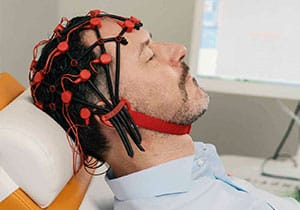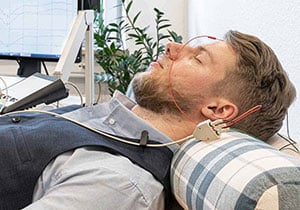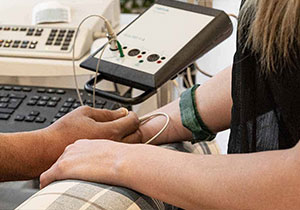
Carpal tunnel syndrome
Carpal tunnel syndrome is the most common bottleneck syndrome in the carpal region. The age of onset is predominantly between the ages of 40 and 70. The syndrome often occurs on both sides.
Causes and symptoms
Carpal tunnel syndrome is a nerve compression syndrome in the area of the carpus. The median nerve of the hand is pinched. This compression, or entrapment, can have many causes:
- Repetitive movements: Activities that require repetitive hand and wrist movements, such as typing or cutting, can lead to overuse of the hand and irritate the carpal tunnel.
- Wrist position: Frequent flexion or hyperextension of the wrist can put pressure on the median nerve.
- Injuries: Fractures or sprains of the wrist can lead to swelling and constrict the carpal tunnel.
- Arthritis: Inflammatory diseases such as rheumatoid arthritis can cause swelling and changes in the wrist bones that narrow the carpal tunnel.
- Hormonal changes: Fluctuations in hormone levels, especially during pregnancy or menopause, can lead to swelling in the carpal tunnel.
- Diseases: Certain diseases such as diabetes, hypothyroidism (underactive thyroid gland) and obesity increase the risk of carpal tunnel syndrome.
- Fluid retention: Conditions that lead to fluid retention in the body, such as kidney disease or pregnancy, can increase the pressure in the carpal tunnel.
- Genetics: A familial predisposition can play a role, as anatomical differences, such as a narrower carpal tunnel, can be inherited.
These causes and risk factors can occur individually or in combination and increase the risk of developing carpal tunnel syndrome.
The most common symptoms include
- Numbness and tingling: Especially in the thumb, index, middle and sometimes the ring finger. These sensations often occur at night or when waking up and can be exacerbated during the day during activities such as making phone calls or driving.
- Pain: Pain in the wrist or hand that can radiate to the forearm or even the shoulder. This pain can also be aggravated during certain activities or movements of the hand and wrist.
- Weakness: Weakness in the hand that makes it difficult to hold objects. Those affected may have difficulty grasping small objects such as needles or coins.
- Loss of coordination: Fine motor skills may be impaired, resulting in difficulty performing precise movements.
- Swelling: In some cases, swelling of the hand may occur, although this swelling is often felt subjectively and is not always visible.
- Sensitivity to cold: The affected fingers may be more sensitive to cold than the rest of the hand.
These symptoms can start gradually and worsen over time if the pressure on the median nerve is not reduced. At an advanced stage, the symptoms can become permanent and lead to significant impairment of hand function. To avoid this, you should definitely seek professional help. We will advise you and help you!




